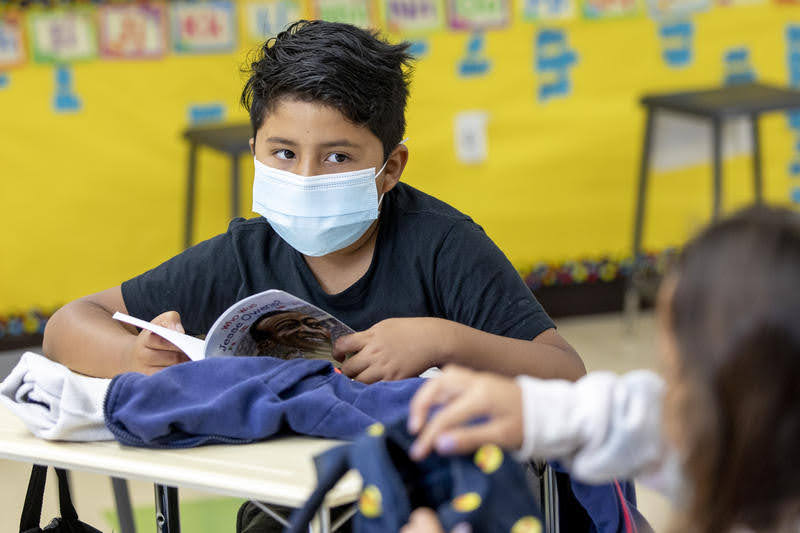[ad_1]
Jessica Christian/San Francisco Chronicle/Polaris
 Jessica Christian/San Francisco Chronicle/Polaris
Jessica Christian/San Francisco Chronicle/PolarisCovid, wildfires, economic uncertainty and persistent racial injustices have upended nearly every aspect of children’s lives in California, according to one of the first comprehensive surveys of young people’s overall well-being since the pandemic began.
The 2022 Children Now Report Card, released Wednesday by the Oakland-based research and advocacy organization, offers a glimpse into the struggles — and victories — children have experienced as the pandemic approaches the end of its second year. Education, child care, physical and mental health, homelessness, poverty, juvenile justice and food security are among the topics explored in the report, which issues A-through-F letter grades based on data and state policies.
“For years, policymakers have been saying, ‘Of course, of course, kids are a priority,’ but what we know is, that it’s not enough,” said Ted Lempert, president of Children Now, which has been compiling the annual surveys since 1990. “The situation is especially grim because of the pandemic, and children have to be our No. 1, No. 2 and No. 3 top priorities. Not ensuring that our children are healthy and educated will have an enormous impact on our economy and our democracy. … It’s doable. We just have to do it.”
Of particular concern is the disparity in learning loss during last year’s school closures. Using data from the Policy Analysis for California Education, the report shows that English learners, low-income, American Indian, Black and Latino students lost far more ground academically in math and English language arts than their white and Asian peers.
American Indian students and English learners, for example, had lost nearly four months of learning compared with just over a week for Asian students. The data is based on third-through-eighth-graders’ scores on interim assessments given in fall 2020 compared with the previous year.
The reason for the disparity is uneven quality in distance learning programs, limited access to technology and the disproportionate impact of the pandemic on low-income families, according to the report.
Another noteworthy statistic is the surge in suicides among Black youth. According to the report, the suicide rate among Black 10-to-24-year-olds has more than doubled since 2014 while the rate among other groups has remained steady or dropped. In 2020, 12 of every 100,000 Black young people died by suicide, compared with a statewide average for all racial groups of just over 6 of every 100,000 young people.
While disturbing, the numbers are not a shock, said Lisa Andrews, a director at the California College Guidance Initiative and a counseling professor at the University of La Verne. The spotlight on racial injustice, as well as continuing violence against Black people, has contributed to ongoing trauma among Black youth, she said. A cultural stigma associated with mental illness and a shortage of Black counselors, meanwhile, has prevented too many young Black people from seeking help, she added.
Schools and other organizations can do a better job addressing mental health challenges among Black young people, she said.
“Teachers can say, ‘Hey, how’re you doing?’ and just spend a few minutes talking about life,” Andrews said. “If students know that someone is concerned, someone cares, it can make a big difference.”
The expansion of transitional kindergarten was a bright spot in the report. California got an A- for its investment in transitional kindergarten for all 4-year-olds, but it needs to do more to ensure that all children have access to early childhood education, the report said. Transitional kindergarten classes should have smaller student-to-teacher ratios and better-trained teachers, and affordable preschool needs to be available for every 3-year-old.
Another bright spot was health insurance. California “has made remarkable progress toward ensuring health coverage for every child” by expanding Medi-Cal to undocumented children and youth ages 19 to 25, the report said.
But even with health insurance, too many children aren’t getting basic medical care, the report said. In some cases, the premiums are still too high for parents to afford, or families don’t know what services they’re eligible for, or health care providers aren’t offering services in a timely way. The report gave California a D- for its health care oversight and accountability.
This is a particular concern during the pandemic, according to the report.
Increased student engagement was a reason for optimism. More students registered to vote — and voted when they became eligible — after California allowed 16-and-17-year-olds to pre-register last year, and took the lead in national movements centered on social justice, climate change and other issues. Nearly half of California’s 18-to-24-year-olds voted in 2020, above the national average and up from 37% in 2012.
“When young people are engaged and empowered, they can be integral partners in shaping the policies that impact their lives,” the report said.
But overall, California needs to do much more to support young people, especially regarding their mental health, Lempert said. He noted that California lags behind most other states in the number of adults on school campuses, including teachers, counselors, tutors, social workers, nurses and psychologists. While the state has been boosting funding for schools for years, it hasn’t been enough to keep up with students’ needs, he said.
“We’ve been sounding the alarm about this for a while,” he said. “This is unacceptable. And the result is incredibly detrimental to kids. We’re behind other states in so many areas, and there is no excuse for that.”
To get more reports like this one, click here to sign up for EdSource’s no-cost daily email on latest developments in education.
[ad_2]
Source link
